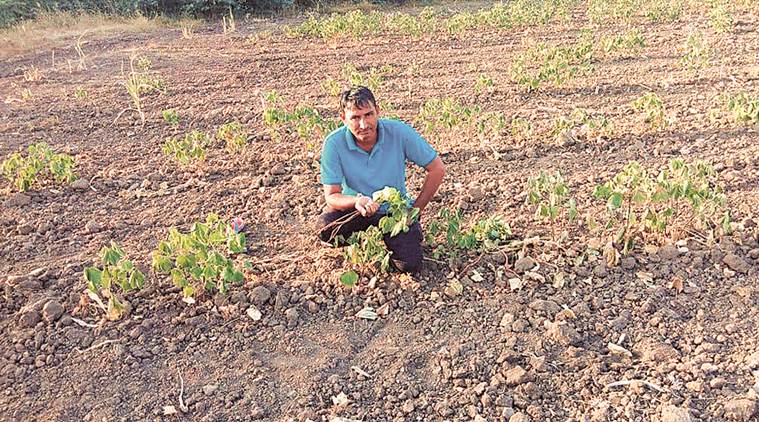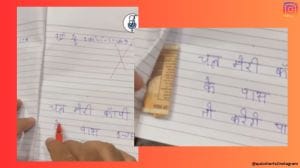- India
- International
Drought woes: Saurashtra farmers stare at a dry harvest
Deficient monsoon rains have impacted the Kharif crop, while also raising doubts over Rabi sowing prospects.
 Farmer Deepak Gadhvi at his dry cotton field in Virvadarka village of Gujarat’s Morbi district. (Photo: Gopal Kateshiya)
Farmer Deepak Gadhvi at his dry cotton field in Virvadarka village of Gujarat’s Morbi district. (Photo: Gopal Kateshiya)
Deepak Gadhvi has reasons to feel both lonely and sad these days. This farmer from Virvadarka village in Maliya taluka of Morbi district, in June, had to part with a cow — which he was rearing to make milk available to his mother suffering from cancer — because there wasn’t sufficient fodder. Even after the monsoon’s arrival in July, the rains failed after the first showers, causing fresh pain for the 46-year-old, this time from watching his Kharif crop fail.
Gadhvi has six hectares, in which he had sown groundnut in three, cotton in two, and bajra (pearl-millet) and green jowar (sorghum) fodder in the remaining one hectare. But apart from the sorghum forage, he has little to harvest this season. Nor is there any scope for planting any Rabi winter crop. “Barring the odd passing showers, it has not rained at all. A minor canal that offtakes from the Maliya branch canal of the Narmada project is our sole irrigation source. But it got damaged in last year’s floods and hasn’t been repaired, leaving us totally at the mercy of the rain gods,” notes Gadhvi.
Virvadarka is located near the mouth of the Machchhu River, where it meets the Little Rann of Kutch. While the village has abundant groundwater, it is salty and not suitable for irrigation. “Last, year, we lost our crop to floods caused by the waters discharged from the Machchhu-II Dam. This time, it has been drought”, adds Gadhvi, an economics graduate, who, in good years, harvests an average 25 quintals each of cotton and groundnut per hectare.
According to data from the Gujarat State Disaster Management Authority, Maliya received only 171 millimeter (mm) rain this southwest monsoon season (June-September), as against its normal long-period average of 474 mm. It has rained even less, at 130 mm, in the neighbouring Halvad taluka, but the farmers there have the cushion of groundwater in some parts and also the Narmada project’s network of canals. Morbi district as a whole has received only 43.63 per cent of its average rainfall, the second lowest after Surendranagar (42.09 per cent) in the Saurashtra region. Saurashtra, Kutch and North Gujarat have had deficient monsoon rains (see table), which could affect both the Kharif crop as well as upcoming Rabi sowings in the state.

In Surendranagar, there are talukas such as Dhrangadhra, Limbdi, Wadhwan and Lakhtar that are getting Narmada water, but farmers in others — Chotila, Sayla, Than and Chuda — are facing drought-like situation similar to those in Maliya. Narendra Khachar has planted cotton in his entire 16-hectares land across two plots at Panchavada village in Surendranagar’s Chotila taluka. The first plot of six hectares has irrigation facility through a bore-well. The second 10-hectare holding gets its water mainly from a small dam about four km away, from where Khachar has laid a pipeline. “The dam did not register any inflow of water, as it only drizzled and that allowed very little runoff. So, I haven’t been able to irrigate my crop in this plot, where the ground-water, too, isn’t of good quality,” says this farmer. Even in the six-hectare plot, the aquifer has not been replenished enough to enable more than a couple of irrigations from the 950-feet-deep bore-well.

Khachar harvested around 280 quintals of cotton from his 16 hectares last year. “This time, I will be lucky to get a quarter of that produce. Even my irrigated field may not yield 40 quintals, while I can hope for another 30 from the other plot. I have spent more than Rs 1.5 lakh on seed, fertiliser, pesticides and field preparation. I am also worried about my four share-croppers, who have spent the same amount (and take away half of the produce as their share),” he states.
Besides the canal network, the Gujarat government has also been laying giant underground pipelines to divert the Narmada waters to 115 reservoirs of the Saurashtra plateau under the Saurashtra Narmada Avataran Irrigation Yojana or SAUNI. The pipelines comprise four links: the first to Morbi, Jamnagar and Devbhumi Dwarka; the second to Surendranagar, Botad and Bhavnagar; the third to Rajkot city; and the fourth to Surendranagar, Rajkot, Amreli and Junagadh. On September 25, the irrigation department began pumping water to link-II, followed by link-IV on October 15.
“The SAUNI water should have come a month ago, when the crop had already started wilting. My cotton crop in 10 bigha (6.25 bigha make a hectare) has shed leaves and irrigating it is of no use now, while the groundnut in another 10 bigha, too, has dried up. Even from my balance 10 bigha, I have managed to harvest only four quintals of sesame seed,” complains Indrasinh Rayjada, a five-hectare farmer from Haddad village of Botad district and taluka. The water through the SAUNI link-II pipeline was released into the Kaniyad Dam, which replenishes his open well and tube-well.
Even in Amreli, whose coastal talukas of Rajula and Jafrabad were flooded in July, the situation is no better. Ramji Gujarati and his four brothers jointly farm 16 hectares land with micro-irrigation systems near Lathi town in the district. They have sown cotton in eight, chilli in four, and groundnut in three hectares, while the remaining one hectare has a lemon orchard. “The rains have been such this time that that I haven’t been able to irrigate half of my cotton crop. There is some water in two out of my four tube-wells, but the 125-feet-deep open well here is almost dry,” observes the 62-year-old.
Saurashtra accounts for more than 70 per cent of Gujarat’s cotton and groundnut production. The region has received barely 73 per cent of its normal monsoon rainfall quota. Even this has been largely concentrated in a few coastal talukas of Bhavnagar, Amreli, Gir Somnath and Junagadh, while leaving the rest of the region dry. As on October 15, only four out of the region’s 138 dams were filled to their capacity. Together, the reservoirs had collectively stored just 39 per cent of their designed capacity. Even major dams like Shetrunji and Bhadar are holding water at 42 per cent of their gross storage.
Farmers in many parts of Saurashtra have been submitting memoranda to the government, demanding that their areas be declared scarcity-hit. In Halvad taluka, farmers staged a three-day relay hunger-strike earlier this month, seeking an increase in the water flow to the Maliya sub-branch canal.
Meanwhile, the Sardar Sarovar Narmada Nigam Limited, the Gujarat government undertaking which manages the Narmada project, has claimed that it is releasing water wherever required through the six sub-branch canals (Maliya, Botad, Vallabhipur, Limbdi, Dhrangadhra and Morbi) fed by the Saurashtra Branch Canal, which, in turn, offtakes from the Narmada Main Canal near Kadi in North Gujarat’s Mehsana district.
“We are committed to provide protective irrigation for Kharif crops and have been supplying water for almost a month. All farmers in the command area have got water to give at least a couple of irrigations. The design of our system requires farmers to take water in turns, but they all want it at the same time. If farmers at the head of a canal keep drawing water, those at the tail-end would have to wait for 5-6 days. We have had to, then, forcibly stop farmers at the head-reach. We are also supplying water to the SAUNI pipelines,” R.K Jha, superintending engineer of the Saurashtra Branch Canal, told The Indian Express.
Apr 16: Latest News
- 01
- 02
- 03
- 04
- 05






































